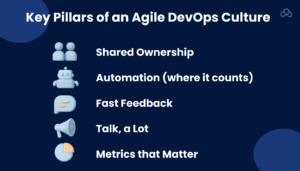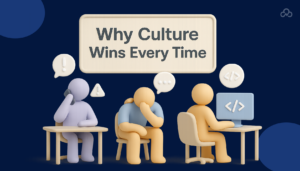You’ve probably noticed how the biggest names in tech, Amazon, Netflix, Google, seem to roll out updates like clockwork. New features, bug fixes, performance boosts… all without the chaos you’d expect from moving that fast.
It’s not luck, and it’s not just because they have huge budgets. A big part of it comes down to how they’ve built their culture around DevOps services & solutions. And no, we’re not talking about installing a few tools and calling it a day. This is about shifting mindsets, roles, and even the way teams talk to each other.
When done right, that cultural transformation isn’t just an internal “feel-good” project, it translates to measurable results. Faster deployments. Fewer outages. Happier customers.
Why Cultural Transformation Matters in DevOps
If you strip it down, DevOps isn’t only a set of practices or fancy automation pipelines, it’s a working agreement between development and operations that says, we build and own this together.
In traditional setups, developers toss their code “over the wall” to ops. The ops team deploys it, prays it works, and cleans up the mess when it doesn’t. That’s fine… actually no, it’s not fine at all. It’s slow, frustrating, and leaves both sides pointing fingers.
By moving to an agile DevOps culture, those silos start disappearing. Teams plan together, test together, and learn from every release. The feedback loop shortens. Problems get spotted earlier. And because deployment isn’t treated like a high-stakes once-a-month event, teams can ship changes with confidence, even daily.
It’s not magic. It’s process plus trust. And yes, tech giants had to fight their own internal resistance to get there. Which means if they can pull it off, chances are your org can too
Lessons from Tech Giants
So, what exactly are these companies doing differently? Here are a few takeaways from those leading the charge in DevOps services and solutions:
– Amazon’s “You build it, you run it” rule. Engineers own their code in production. That ownership means fewer handoffs, quicker fixes, and way less finger-pointing.
– Netflix’s chaos engineering. Instead of avoiding failure, they simulate it, on purpose, to make systems stronger. A bit terrifying, but it works.
– Google’s blameless post-mortems. When something breaks, they investigate without scapegoating. The goal? Learn, not punish.
Across these examples, a pattern emerges: cultural transformation isn’t a side effect of DevOps, it’s the engine. The tooling (CI/CD pipelines, container orchestration, managed DevOps services) is just fuel, culture is what makes the machine run without grinding to a halt.
And here’s the kicker: even with all their resources, these companies didn’t get it right the first time. There were false starts, bad tool choices, and the occasional “let’s never do that again” project. That’s normal.
Key Pillars of an Agile DevOps Culture

Forget the fancy diagrams for a second. The companies that actually pull off a strong agile DevOps culture aren’t doing anything mystical, they just keep showing up and doing a few things right, over and over:
– Shared ownership. No more “my code, your problem.” If it’s live, it’s everyone’s problem. Period.
– Automation (where it counts). Testing, deployments, rollback scripts… the boring stuff that eats time.
– Fast feedback. You find out something’s broken in minutes, not after a customer tweets about it.
– Talk, a lot. Could be Slack, stand-ups, random hallway chats. Point is, don’t let info sit in one person’s head.
– Metrics that matter. Not vanity charts. Stuff like deployment frequency, MTTR, and change failure rate.
None of this stays perfect forever. Teams grow, tools change, and you’ll find yourself re-tuning the same processes more than once. The companies using DevOps services & solutions well know culture is never “done”, it’s a moving target.
Integrating DevOps Services & Solutions Without Losing Your Soul
You can absolutely build everything in-house. It’ll just take longer, cost more, and maybe push a few people to the edge of burnout. That’s why a lot of teams call in managed DevOps services or DevOps consulting and managed services.
And no, it’s not “outsourcing your culture.” You still own the way your people work, you’re just letting someone else bring in the scaffolding so you don’t waste months reinventing it.
One fintech I know went from 10-day deployment cycles to under 48 hours. Not by hiring a hundred new engineers, but by bringing in a provider who set up CI/CD, got container orchestration running, and handed the keys back with training. That saved them a year of trial-and-error.
If you go down this path, don’t pick a provider that just drops in tools and disappears. You want one that hangs around for the messy part, coaching, troubleshooting, and making the process yours.
The Pitfalls People Still Fall Into
Even big names mess these up:
– Buying tools before fixing the process.
– Automating everything (even stuff that really needs human eyes).
– Thinking culture change is a workshop, not a daily thing.
– Ignoring the data, because “we feel faster” isn’t proof.
The smart move? Catch these early. A quick course correction in month two is a lot cheaper than untangling bad habits in year two.
Getting Started Without Overthinking It
Changing how your teams work doesn’t have to be a “big bang.” Pick one thing, just one, and make it better:
1. Automate the slowest part of your pipeline.
2. Track a metric you can actually move in the next month.
3. Use tools that your team likes using, not just ones with the flashiest marketing page.
4. Pull in outside help when it’s worth it. DevOps consulting and managed services can save your team’s weekends.
5. Write down what worked, and what didn’t.
Start there. Repeat. It’s boring advice, but boring is good when you’re aiming for predictable, repeatable success.
Technical FAQs
Q1: How are managed DevOps services different from in-house?
They come with ready-made expertise and proven workflows. In-house can work too, but you’ll spend more time building the knowledge base yourself.
Q2: Where do DevOps services & solutions fit into an agile DevOps culture?
Think of culture as the “why” and services as the “how.” One without the other doesn’t get you very far.
Q3: Will managed DevOps services work with our tech stack?
Yes, if they can’t, they’re not worth hiring. The good ones slide into AWS, Azure, GCP, hybrid… you name it.
Q4: How do we know if it’s working?
Ship faster. Break less. And hear fewer “why is this down?” messages at midnight. Track deployments, MTTR, and failure rates.
Why Culture Wins Every Time

You can buy all the automation in the world, but if no one feels responsible for what happens after deploy, you’ll still stall out. The tech giants figured this out early, culture shifted before the toolsets did.
Culture shows up in the small stuff: who answers the call during an outage, how people share bad news, and whether the dev who built it is there when it ships. Tools will change. Culture sticks.
Final Word
The pressure to deliver faster isn’t going away. DevOps services & solutions give you the safety nets, automation, and speed you need, but your culture? That’s the engine.
Start with one fix. Make it stick. Then move to the next. Before long, you’ll wonder how you ever shipped software the “old” way.
Do you like to read more educational content? Read our blogs at Cloudastra Technologies or contact us for business enquiry at Cloudastra Contact Us